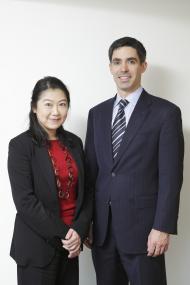Drew Edwards

- Classification
- Equity
- Company
- Advisory Research, Inc.
Drew Edwards, 12 years of investment experience, serves as a Portfolio Manager of Advisory Research. Prior to joining Advisory Research, he was an investment professional at Taiyo Pacific Partners, an activist fund backed by CalPERS and W. L. Ross that focuses on Japanese equities. Previous to Taiyo, he worked as an investment banker at Lehman Brothers and as a finance executive in the healthcare industry. Drew holds a B.A. in International Business from Sophia University (Tokyo), an M.B.A. from Kellogg School of Business and a J.D. from Northwestern University. He is a member of the California State Bar and is proficient in Japanese.?

We are value investors. Our approach to investing is underpinned by the simple mathematical fact of asymmetrical compounding returns the fact that it takes a 100% positive return to offset a 50% decline in value. In our view, the goal of minimizing risk and losses is a critical part of maximizing long-term investment returns.
We begin assessing an investment opportunity by asking ourselves “what is the downside risk here?” This assessment is centered on 3 important things investors can do to minimize investment risk:
First and foremost, do not overpay for assets. For us, this means investing at an a price that we feel is attractive relative to the net asset value of a company. We are more confident that we are not overpaying for a company when we invest at a valuation lower than the liquidation value of the company’s assets.
Second, minimize financial risk by investing in well-capitalized companies. Companies that maintain excessively leveraged capital structures represent liquidity and solvency risks with which we are not comfortable. Additionally, as the recent financial crisis has demonstrated, companies that require continual access to fully functioning financial markets to fund operations can become risky very quickly during uncertain economic times.
Third, we seek to minimize fundamental business risk by understanding the business, management motivations and the broader competitive environment. We avoid investing in companies when we do not understand the core technology or business model. Understanding managements’ motivations, as well as the motivations of other shareholders, is an important part of our process. Even when a company otherwise appears to be an attractive investment opportunity, we avoid situations where management is motivated to act in a manner that conflicts with the interest of minority shareholders.
After gaining comfort with the downside risks, we subsequently move on to assess the upside opportunity. We look for companies with management teams who recognize that their company is trading at unreasonably low valuations and clearly articulate a credible plan to close the valuation gap. Frequent examples include asset rationalization or improved capital management plans, international expansion strategies, cost cutting programs, etc.

I definitely encourage investors who have hesitated to invest in Japanese equities to take a closer look. At ARI, we hunt for what we believe are attractive investments worldwide. As we scour the world, we are finding that some of our most exciting opportunities are located in Japan.
We feel the downside risk of Japanese equities is limited. It is our belief that low valuations, strong balance sheets, high dividend yields and solid business models with dominant market positions which are associated with a great number of Japanese companies should provide downside support if the macro environment worsens due to a continuation of the financial crisis or global recession. Japanese corporations have already gone through two decades of financial restructuring that the West has just begun. Generally, Japanese financial institutions and corporations have stronger balance sheets and more efficient operations than a few years ago.
Upside opportunities in Japanese equities are compelling, in our opinion. Japanese companies that can use their balance sheets to their advance can experience relative growth as they are able to invest in their businesses at the same time that over-levered overseas competitors are being forced to cut back. They also are able to acquire assets from distressed sellers at attractive prices. These factors should be good from a growth perspective, as well as an ROE perspective as idle capital is being put to work.
In many respects, the current environment in Japan reminds me of opportunities investors experienced in the US in the 1980’s cheap valuations, overcapitalized balance sheets, opportunity to create value streamlining conglomerates and “changing of the guard” from financially conservative Great Depression / WWII generation managers to managers with a more aggressive posture.
Finally, bottom-up investors have the opportunity to take advantage of market inefficiencies in Japan. While larger companies with overseas ADR listings are closely followed, we believe that smaller domestic companies are frequently misunderstood and temporarily out of favor. This is probably because fewer global investors are paying attention to the Japanese market on a company-by-company basis, and most equities receive weak sell-side coverage at best.

I have had the opportunity to speak with foreign investors from around the world regarding their experiences investing in Japanese equities. For those that have struggled with their Japanese investments, I would most commonly attribute their struggles to 2 things:
On one end of the spectrum, growth investors have found Japan to be particularly challenging. Paying high valuations with the hope of growth is a risky proposition in all markets; Japan is certainly no exception. In fact, perhaps more than any other developed market, value investing has outperformed growth in Japan.
On the other end of the spectrum, some investors have struggled in Japan because their investment decisions were strictly based upon cheap valuations metrics without adequate consideration of corporate governance. In countries with active markets corporate control, like the US and UK, investors can take some comfort that the market will correct situations where managers chronically underperform. In these markets, publicly listed companies that persistently trade below their intrinsic value are frequently purchased by buyers that can make better use of the assets. This market mechanism provides discipline and closes unreasonable valuation gaps.
The market for corporate control is not as active in Japan. As a practical matter, managers who chronically underperform are not subjected to the same level of market discipline. Consequently, when investing in Japanese equities, it is important to closely consider issues of corporate governance, manager motivation and shareholder structure. By way of example, managers of publicly listed subsidiaries frequently place primary importance on enriching their parent company rather than maximizing the value of corporate assets. Similarly, management of “owner gaisha” is frequently motivated by issues of family succession and estate planning rather than generating economic returns. When management acts upon these primary motivations at the expense of minority shareholders, the shareholders become frustrated. Therefore, in my opinion, it is important for investors to pay close attention to issues of corporate governance, shareholders structure and management motivation to avoid value traps in Japan.

Advisory Research, Inc. (ARI) was founded in 1974 to provide investment management services to a select group of clientele that shared our founder’s vision. This vision was based upon the idea of generating superior long-term results by protecting capital on the downside while generating consistent returns on the upside. Back then, like today, most investors focused on growth and projected earnings-based valuations. Our founder, who recognized the impossible task of accurately projecting earnings and cash flows, emphasized the importance of balance sheet-based valuation. Since our firm was founded, academic research by Fama and French have affirmed that this approach, when applied consistently, has generated superior risk-adjusted returns.
Today, ARI manages over $7 billion in assets for clients including pensions, university endowments, and foundations. We have expanded our offering to include strategies such as International and Global, but our fundamental investment philosophy and process has been consistent since the firm was founded.

I have always been fascinated by business and investing. As a high school student in the 1980’s, I recall following prominent Wall Street players in a manner similar to sporting events followed by my friends. One investor that particularly grabbed my attention was an oilman that lived in my hometown named T. Boone Pickens. While Pickens was a wildcatter oilman, he cleverly realized that it was cheaper for him to buy energy assets on Wall Street than it was to extract them from his oil fields. I studied everything I could about investors in the 1980s to the point of skipping school to attend a public hearing in which a prominent investor was debating with local politicians about his investing activity. What I learned from Wall Street players when I was in high school in the 1980’s influenced my decision to enter this business. They also influenced my asset-oriented investing philosophy.
In high school, I also developed a fascination about Japanese business practices and what was referred to in the U.S. at that time as “the Japanese economic miracle.” Consequently, I moved to Tokyo to attend college. Japan has remained an important part of my life ever since.
I have been extremely fortunate to be able to combine my professional passion for investing with my deep interest in Japan. I am increasingly analyzing Japan within a broader global context, which I believe is important considering Japan’s gearing toward surrounding Asian markets. My appreciation of the attractiveness of Japanese equities has been enhanced by this global perspective.

I highly recommend Graham and Dodd’s book Security Analysis as a starting point for anybody interested in investing. Benjamin Graham is generally regarded as the father of value investing. The lessons that Graham provides in this book are the foundation for many of the worlds’ most successful investors.
Another great book on value investing is Seth Klarman’s Margin of Safety. This book, which has a cult-like following by value investors, is unfortunately no longer in publication. Fans pay thousands of dollars for original copies.
Value Investing is a book based upon a collection of articles written by James Montier. Montier’s discussion of behavioral finance is particularly helpful in understanding why market behave in a manner that deviates from what we were taught in our modern financial theory classes in business school. Montier also provides eloquent critique of the pseudo sciences of modern investing, such as VAR, DCF-based valuations and others.
My daily routine begins by reading portfolio company and market news on Bloomberg. After Bloomberg, I read news that is pushed to me via email from Financial Times, Wall Street Journal, Nikkei and other subscription services. My favorite weekly journals are Economist and Nikkei Business.
Outside of these core media sources, there are many trade journals, analyst reports and infinite information online from industry organizations and other sources. However, in this industry, I think it is easy to become paralyzed from information overload. I think it is important to make enough time for regular discussions with portfolio company management teams, their customers and their competitors located in various markets. Sometimes we get the most valuable information regarding our Japanese investments opportunities from conversations with competitor, customers and suppliers located in Germany, Korea or China, for example.
Interviewer:
Akane Hashimoto
Managing Director, Investment and Research
Photographer:
Wataru Sato
Notes:
This article originally appeared on March 16, 2012. Any views presented in this article are as of such date and are subject to change
This article and the information provided therein is not a recommendation to purchase or sell any security, nor is it intended to constitute the marketing of, or a solicitation for investment in, any investment product.
Advisory Research is a value-oriented investment firm with over $10bn in assets under management. We manage U.S. and international equity strategies as well as fixed income assets for institutional, private clients and investment advisors. Advisory Research was founded in 1974 on the principles of value investing and the commitment to provide premier investment management coupled with the best in client service. For over 36 years, our time-tested, disciplined investment approach has focused on preserving and increasing our client’s assets.
Advisory Research takes a disciplined, value-driven approach to managing assets in the U.S. and international markets. We are dedicated to unlocking value in the companies in which we invest, across industries and regions, through rigorous analysis and management engagement. Investing in this profile of companies has provided the historical benefits of relative downside protection with meaningful upside participation and long-term out performance over market cycles.
The Advisory Research investment strategy is a bottom-up, fundamentally-based investment discipline that is executed by a team of portfolio managers and research analysts. Investments for each strategy are selected from a universe of securities in the appropriate market capitalization range. The portfolio construction process uses a combination of quantitative and qualitative analysis to arrive at a diversified portfolio of what we believe are attractively valued securities. All research is constructed with the goal of fully vetting ideas and identifying optimal investment opportunities.
The strategy is team-managed and the responsibilities are shared by each portfolio manager. The portfolio managers are ultimately responsible for buy/sell decisions and they have the ability to veto any buy/sell decision.

March 16, 2012
by Investment in Japan

